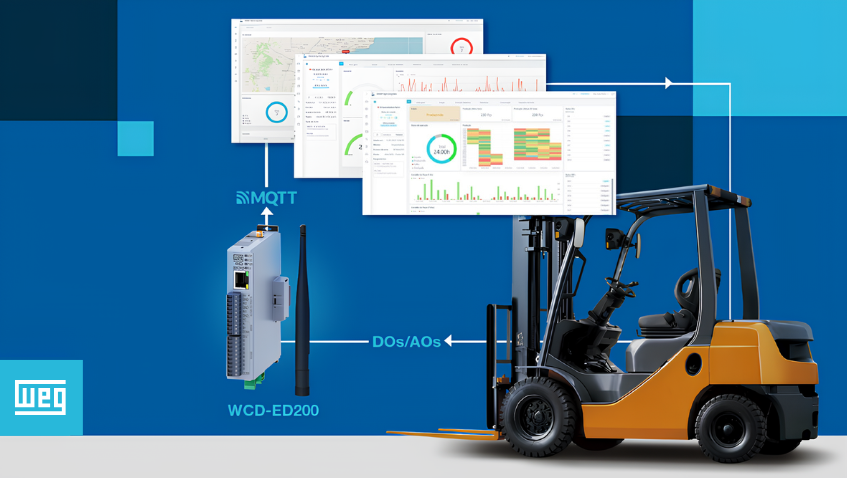WEG has completed the first phase of practical connectivity tests to 5G network of the WEG/V2COM Open Lab.
In partnership with the Brazilian Agency for Industrial Development (ABDI) and the National Telecommunications Agency (Anatel), the project had its first milestone this week at one of WEG's factories, located in Jaraguá do Sul, state of Santa Catarina. The objective is to test the connectivity of several IoT devices for 5G network, contributing to the development of viability for the industry using 5G technology.
"We carried out tests evaluating the performance and coexistence of devices and antennas with 5G technology in a real environment, to gather information on frequency bands, latency, power and other features necessary for industrial applications. Additionally, we will give our contribution to Anatel´s Public Survey", says Guilherme Spina, director of V2COM, a company of the WEG Group. As stated by Guilherme, the first results already show that the 5G technology provides good levels of security, connectivity quality, stability and high speed, much better than those previously offered by 3G and 4G. “The transfer rate, or the amount of data that can be transmitted per second between connected devices, both in download and upload, is higher than that allowed by 4G and Wi-Fi technology. However, the main highlight for the 5G connection is its reliability, which makes it much more stable to be sent and received between devices connected to the network, turning it faster and resilient”, explains Guilherme. All tests took place with the use of more than one 5G network at the same time, a network provided by a telecom operator and a private one with local infrastructure, in order to gather data and information to Anatel and support the process of defining requirements and utilization of frequency bands for the regulation and granting of private networks for industrial use in Brazil.
For Anatel, the practical results of this phase contribute to the 5G potential evaluation, specially in relation to the operating features, considering the power irradiation limits defined by regulations. “These tests will not only help Anatel with regulation, but will help companies to evaluate the economic feasibility of using 5G in private networks. In addition, the tests will generate data for new business models. With this project, ABDI makes existing technologies accessible to the productive sector, in search of greater efficiency, productivity and competitiveness”, says ABDI´s President, Igor Calvet.
About practical tests
The connectivity tests to 5G network are being carried out in one of the most automated, robotic factories and with the highest level of automation and monitoring of the factory floor at WEG, located in Jaraguá do Sul. Antennas with 5G technology installed on the factory's conveyor belts have enabled Wi-Fi communication with a Logistics Robot, which delivers and receives parts at four different collection points. When the main path taken by the robot is obstructed, this robot can identify and use alternative routes, since it also has antennas that connect with the conveyor belts through the 5G network. Intelligent Devices like this Logistics Robot already exist in industrial environments, but they are not in large scale due to data transmission capacity challenges and difficult access to connectivity, given the low Wi-Fi range capacity, or the limitation of installing ethernet cables. Using 5G it is possible to increase the number of connected devices and provide greater connectivity capacity to them, allowing the massive scale of intelligent devices in the industry.
The results were also satisfactory in connectivity tests of the inspection robot that uses virtual reality. Among the applications of this type of robot, we can mention the possibility for professionals to carry out production or inspections monitoring remotely, without having to physically going to the site. This is a purely 5G scenario as it requires high data transmission capacity with fast response time, and is therefore a direct case of validation of 5G capabilities.
Another practical case already tested at WEG is the MVISIA smart camera, installed in the corridor that gives access to the factory entrance to immediately identify, with the use of artificial intelligence, whether the employee/visitor has or does not have a protective mask against Covid-19. An intelligent camera was also installed to scan all sides of a given product in order to identify eventual defects, a process that was carried out manually in the past. In these cases, it has been proven that 5G connectivity is a viable replacement for wired connectivity, allowing for a greater presence of this type of equipment and flexible installation in points of interest not reachable today.
Benefits generated by the project are not limited just to the tested utilization cases. For example, we can mention the use of computer vision for various applications, such as checking the quality of painting on vehicles in the automotive industry; analyzing the materials contained in the mining conveyor belt; similarly in the case of agribusiness with the analysis the quality of grains; analysis of images in public safety systems; analysis of images and data obtained through drones. In other words, any application that uses computer vision with Artificial Intelligence processing can use the results obtained by this project.
“We tested several other utilization cases and, for all of them, the results obtained showed that the levels achieved are consistent with the expectations of the 5G network, allowing the expected gains with the new technology and maintaining the fulfillment of the functional requirements for each one of them. The 5G has proven to be an excellent accelerator for the digital businesses transformation, integrating and boosting industrial robotization in a safe and efficient way”, emphasizes Guilherme.
Other partners in the project:
To carry out the tests in an industrial environment, WEG was monitored by the National Telecommunications Agency (Anatel), and the participation of other partners like Qualcomm for the project technical support, Claro for the implementation of the mixed private network (integrated), and Nokia, as infrastructure provider of independent private network.



